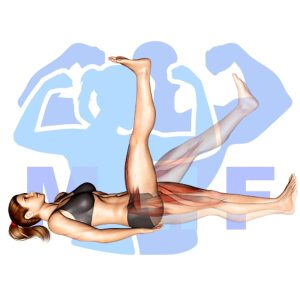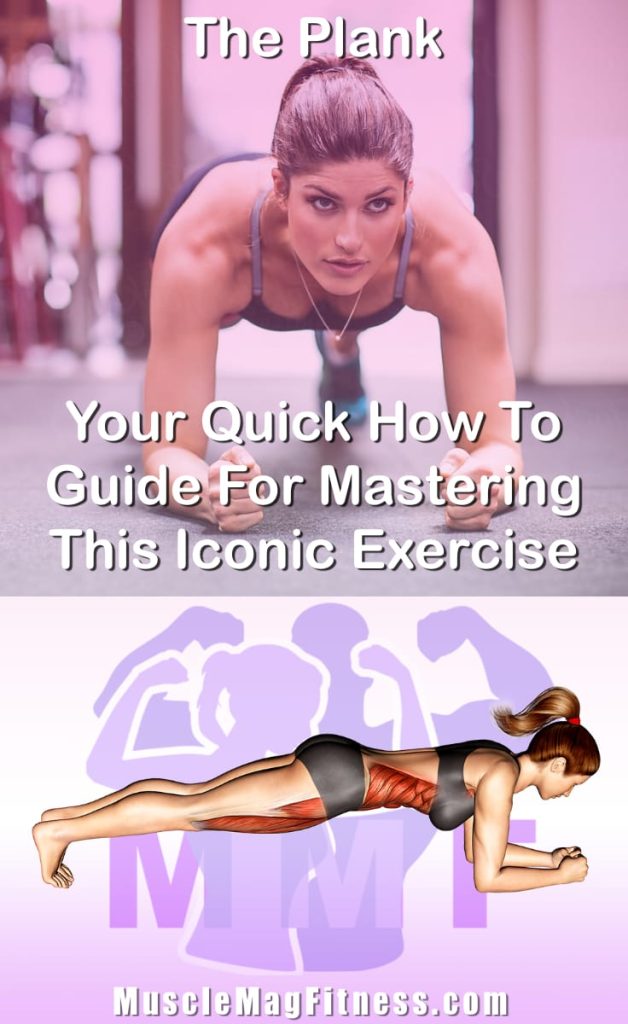Do you find yourself struggling with core strength during your workouts? Are planks leaving you feeling defeated and frustrated? Don’t worry, you’re not alone. Many individuals struggle with holding proper form during the plank exercise. The truth is, poor form is often a result of a weak core and lack of engagement in other stabilizing muscles. But fear not, with a few tweaks to your plank form and incorporating the tips shared in this post, you’ll be able to transform your plank from a weakness to a strength in no time.
Plank Summary
- Primary Muscles: Rectus Abdominis
- Secondary Muscles: Iliopsoas (Psoas Major & Iliacus), Obliques, Pectoralis major, Quadriceps, Sartorius, Serratus Anterior, and Tensor Fasciae Latae
- Equipment: Body Weight
- Mechanics Type: Compound
- Force: Pull
- Utility: Basic

Plank Instructions
- Start out by laying down on a surface with good support.
- Next, lift yourself up onto your elbows and toes, with your elbows directly under your shoulders and your feet together.
- To effectively work your core keep your back and your legs in a straight line.
- Holding the plank for as long as your can is a great core workout.
Video Tutorial
Plank Muscles
Target (Agonist)
Synergists
- Iliopsoas (Psoas Major & Iliacus)
- Obliques
- Pectoralis major
- Quadriceps
- Sartorius
- Serratus Anterior
- Tensor Fasciae Latae
Dynamic Stabilizers
- None
Stabilizers
- Latissimus Dorsi
- Pectoralis Major – Sternal
- Pectoralis Minor
- Trapezius – Lower
Antagonist Stabilizers
- None

Benefits of Plank
The plank exercise is a great way to target the rectus abdominis, also known as the “six-pack” muscle. By holding the plank position, you can work to engage and strengthen your core, which includes the rectus abdominis. This exercise can also help to improve your posture and balance, as well as helping to protect your lower back from injury. Additionally, performing the plank can help to increase your overall strength and endurance, allowing you to perform more advanced exercises with ease.
Tips for Performing Plank
If you’re seeking to take the plank to a new level, then you’re at the right place. These tips will help you get more from of this amazing workout, and help you receive all the benefits it has to give. You’ll have the ability to shape your abs muscles, and minimize your chance of injury. So let’s get started and look at what these tips can accomplish for you.
- 1. Keep your core tight: Engaging your core and abdominal muscles is essential to proper form when planking, as it helps to keep your body in alignment and prevents injury.
- 2. Don’t forget to breathe: Focusing on your breath and taking slow, deep breaths can help you remain in the plank for longer and ensure that you are receiving the full benefit of the exercise.
- 3. Work your way up: Start with shorter planks and gradually increase in duration as your strength and endurance improve. This will help you work up to your goal without risking injury or burnout.
Benefits and Tips Video
Frequent Mistakes To Avoid
When performing plank, keeping away from typical errors can be the difference to getting the most out of the exercise and preventing pain. Moreover, achieving optimal results from this exercise requires proper technique, and avoiding make any typical errors can allow you to perform the exercise better and achieve your desired results. Not only can preventing these mistakes increase your strength, but it can also assist in you feeling more assured and motivated when at in the gym. Thus, it is now your turn to maximize your results from this exercise and experience the advantages of a successful workout.
- 1. Not Holding Proper Form: Plank is all about keeping your body in a straight line and engaging your core muscles. If you don’t maintain the proper form, you won’t be able to reap all the amazing benefits of this exercise.
- 2. Doing Too Long of a Plank: Planking for too long can put stress on your body and can lead to injuries. It’s important to listen to your body, stay within your limits, and build up your plank time gradually.
- 3. Not Engaging Your Core: The Plank is all about engaging your core, so it’s important to make sure you are squeezing those muscles tight during the exercise. If you aren’t engaging your core, you won’t be toning your midsection as much as you could be.
Find More Bodyweight Exercises Here
Variations and Complementary Exercises
There are numerous variations, complementary, and alternative exercises to the Plank that can help you mix up your routine and target different muscles. These exercises will work similar muscles as the Plank, but allow you to work on different parts of the body.
Lying Straight Leg Raise

The Lying Straight Leg Raise is an excellent complementary or alternative exercise to the Plank. This exercise works to strengthen your core and improve stability in your hips and pelvis. To perform the Lying Straight Leg Raise, lie flat on your back with both legs straight. Keeping your core tight and back flat against the floor, lift both legs off the ground until they form a 90-degree angle with your body. Hold this position for 10-15 seconds before slowly lowering your legs back to the starting position. The Lying Straight Leg Raise is an effective exercise for developing strength in your core and glutes, as well as improving balance and coordination.
Lying Alternating Leg Raises

Lying Alternating Leg Raises are a great complement to Plank exercises. This exercise specifically targets the lower abdominal muscles and hip flexors which are often neglected in Plank exercises. To perform this exercise, lie flat on the floor with your arms at your sides and your palms facing down. Slowly lift one leg up, hold for a few seconds, then lower it back to the starting position. Alternate legs and repeat for 15-20 repetitions. Not only will this exercise help build core strength, but it also helps improve balance, posture and stability.
Lever Lying Crunch (Machine)

The Lever Lying Crunch machine is an effective alternative to the plank exercise, providing a great core workout. It works the abdominal muscles in a similar way as the plank, but with an added crunching motion. This crunching motion ensures that the muscles in the lower abdomen are being worked as well as the upper ones. The Lever Lying Crunch machine also helps to strengthen the obliques, which is an important part of core stability. This machine can be used as a complementary exercise to the plank, or it can be used as a substitute for those who are not able to perform the plank properly.
Check Out These Top Bodyweight Exercises
Legs Up Crunch

Legs Up Crunch is a great complementary or alternative exercise for the Plank. It works the same core muscles, as well as the arms, shoulders, and back. To perform the exercise, you start by lying on your back with your legs bent and feet flat on the floor. Then, you lift your legs off the ground and crunch your upper body up towards your knees. This exercise increases stability and strengthens your entire core while also providing a greater challenge than the Plank.
Leg Raise Hip Lift

Leg Raise Hip Lift is a great complementary exercise for the Plank. It works the same muscles as the Plank, but with a slight variation. It involves lying on your back and lifting your legs into the air while simultaneously lifting your hips off the ground. This movement engages the core muscles and helps to build abdominal strength and stability. It also helps to increase flexibility in the hip flexors and glutes. The Leg Raise Hip Lift is an excellent alternative to the Plank for those looking for a more dynamic abdominal exercise.
Knees Up Crunch

Knees Up Crunch is an effective core-strengthening exercise that can be used as a complement or alternative to the Plank. This exercise focuses on the abdominal muscles and utilizes body weight to target the deep core muscles. It is performed by lying on the floor with your knees bent and feet flat on the floor. From there, you lift your upper body off the floor, bringing your knees up towards your chest and crunching your abs. This exercise can be used as a dynamic variation to the Plank, as it adds a greater range of motion to target more muscle groups.
Find More Abs Exercises Here
Opposing Complementary Exercises
In addition to the Plank, it is important to add exercises that work opposing muscle groups in order to create balance in your core and avoid injury. Below are a few exercises that will help you to target opposing muscles.
Straight Leg Cable Pull Through

The Straight Leg Cable Pull Through is a great complement to the Plank exercise, as it works the opposing muscle groups. This exercise works the glutes and hamstrings while the plank works the core and shoulders. By working these opposing muscle groups, athletes can create a balanced lower body workout. The Straight Leg Cable Pull Through can be done with either an overhand or underhand grip and can be done with a variety of weights for different levels of difficulty. This exercise can also be done with a cable machine or resistance bands for added intensity.
Bird Dog Plank

Bird Dog Plank is a complementary exercise to the traditional Plank. It is an advanced core exercise that works the opposing muscle groups of the Plank to help strengthen and stabilize the spine. This exercise targets the back muscles, as well as the glutes and core, to help improve posture and balance. By engaging the opposing muscle groups in both exercises, you can ensure that your body is evenly worked and that you are receiving a full-body workout. Bird Dog Plank helps to build overall strength, stability and balance, making it an essential addition to any fitness routine.
45 Degree Twisting Hyperextension

The 45 Degree Twisting Hyperextension is an excellent complementary exercise to the Plank. This exercise works the opposite muscles of the Plank – the hamstrings, glutes, and lower back – and helps to increase flexibility in the spine. The twisting action of the hyperextension helps to further stretch and work the lower back, while engaging the glutes to a greater degree. This exercise also strengthens and stabilizes the core, making it an ideal exercise to pair with the Plank in any workout routine.
Plank Your Way to a Stronger Core
A strong core is essential for overall fitness and daily activities. Planks are one of the best exercises to strengthen your core muscles. Planking involves holding a push-up position while keeping your body straight and stable. This exercise targets your abs, back, and shoulder muscles. Planks can be modified to increase or decrease the intensity, making them suitable for all fitness levels. Incorporating planks into your workout routine will not only help you achieve a stronger core but also improve your posture and balance. So, start planking your way to a stronger, healthier you!
References: Wikipedia | ExRx.net | PubMed.gov | Comprehensive List of Abs Bodyweight Exercises

